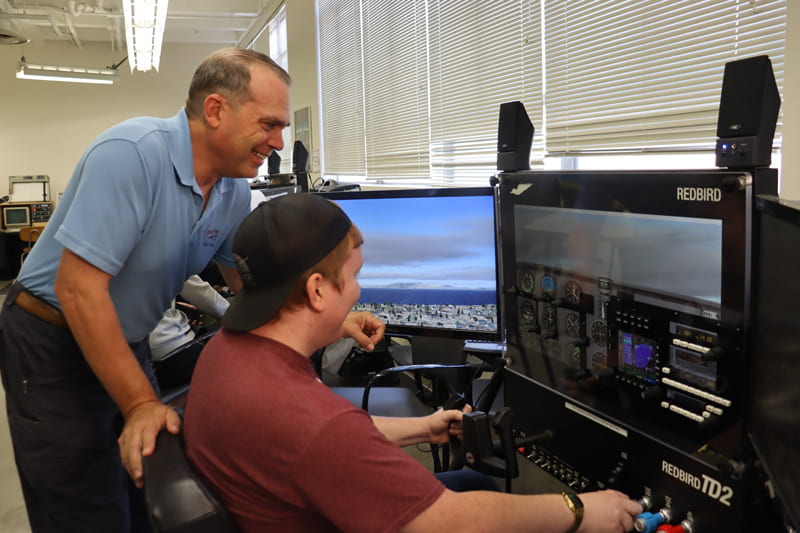Morongo Scholarship Helps Native American Aviation Student Take Flight

“My objective is to give back and support my Indian heritage with a goal to fly air ambulance aircraft for the Navajo Nation,” he said. “The Navajo Nation uses aircraft for medical evacuation because of vast distances between settlements within the reservation. It would also make my grandfather very proud if I were to ever fly in the military, since that was the one thing he wasn’t able to do.”
Last month, Goodwin received a $10,000 scholarship as part of the 17th annual Rodney T. Mathews Jr. Scholarship Program from the Morongo Band of Mission Indians near Palm Springs.
Scholarship applicants are considered based on their academic success and community service, and must be actively involved in the Native American community. The scholarship honors a late Morongo tribal member, Rodney T. Mathews, Jr., who passed away in 2004. He worked as an attorney for 20 years before serving as a judge pro tem for more than a decade.
“Through our Rodney T. Mathews Jr. Scholarship program, Morongo is helping reverse the trends that have left Native Americans as the most underrepresented group in colleges and universities,” Morongo Tribal Chairman Charles Martin said. “Students like this year’s recipients will be the tribal leaders of the future, and we are pleased to be helping them acquire the education and skills they need to guide and improve tribal communities for the next generation.”
Since the program’s inception, there have been 55 scholarships totaling $550,000 awarded to Native American students attending universities across the country. The scholarship program is open to any enrolled members belonging to one of California’s more than 100 federally recognized tribes.
According to the U.S. Department of Education, American Indians and Alaskan Natives comprise less than 1% of the nation’s college students, the lowest college enrollment rate of any ethnic group.
“Since I am a registered member of the Wailaki Indian tribe, I searched for [American] Indian scholarships and applied for [two of them],” said Goodwin. “I was surprised to learn that I was awarded $10,000 per year for two years. This scholarship will enable me to obtain my instrument rating and commercial pilot certificate.”
Goodwin is inspired in large part by his grandfather, SJSU alumnus Wesley David Wardall, ’71 Aero Operation, who he said has been in the aviation field for 55 years and spent 34 years serving as deputy chief for air tanker operations with California Department of Forestry and Fire Protection (CAL FIRE). According to Goodwin, his grandfather also did consulting work for NASA, the United States Navy and Army, as well as various airlines following his retirement in 2008.
“I’ve been very lucky to be exposed to all this experience and spent many visits to the CAL FIRE depot facility and outlying bases,” said Goodwin. “My grandfather has inspired me in many different ways as not only a pilot but as a person. I’ve flown with him in the western U.S. on many trips for the last 12 years.”
Goodwin earned his private pilot certificate this September. He said it took him about five years to meet that goal, as he was attending school, participating in Boy Scouts and working part time. He and his two sisters were raised by a single mother, so he often devoted his personal time to help provide for his family. He attributes his success to the support of his family and his tribe.
“My first solo flight was exciting as I took to the controls and started practicing maneuvers on my own,” he recalled. “I felt like I was the most free I’ve ever been in my life until I had to land the plane on my own. Besides flying the aircraft with precision needed to pass the flight test, landing was the most difficult part of flying even after gaining some proficiency.”

Lecturer Clayton Conrad provides instruction to Goodwin in SJSU’s flight simulator lab.
In SJSU’s flight simulator lab, there are a number of simulators with varying levels of performance and sophistication, so students gain critical “hands-on” experience. Goodwin said they look just like the controls of the aircrafts he’s flown on his own so far.
According to aviation and technology Lecturer Clayton Conrad, the simulators students use in the laboratory on campus are near exact to those in real planes.
Related Stories

Lucas College and Graduate School of Business Ranked in Top 40 Online MBA Programs, No. 1 Among California Public Universities

More Than 5,700 Spartans Earn Their Degrees at SJSU This Fall

SJSU’s Rome Drori and Team Win First Place at Sushi Hackathon

